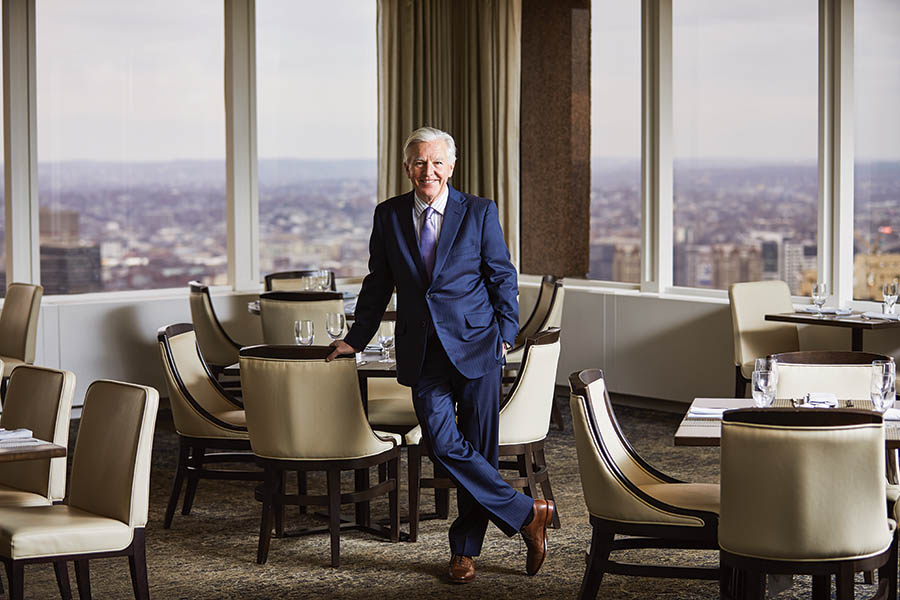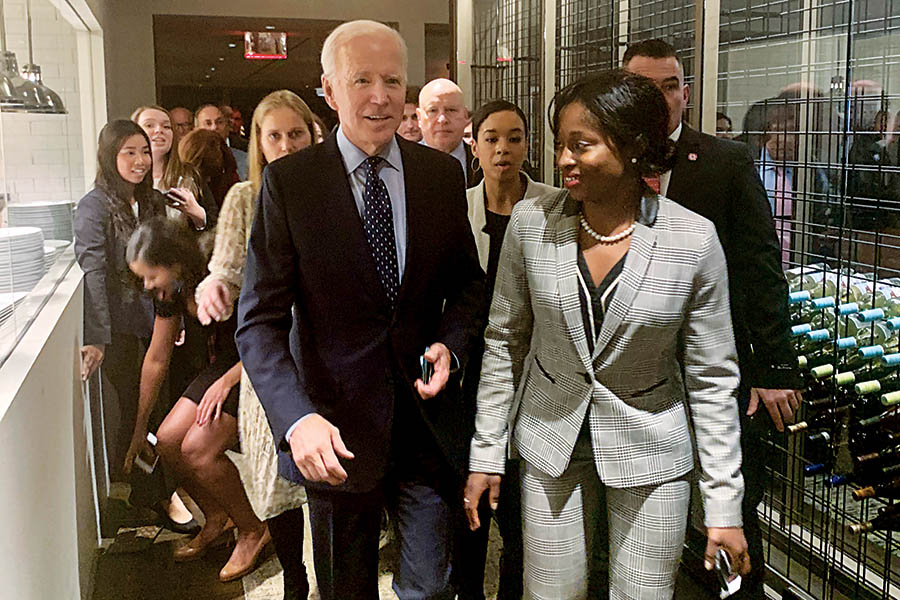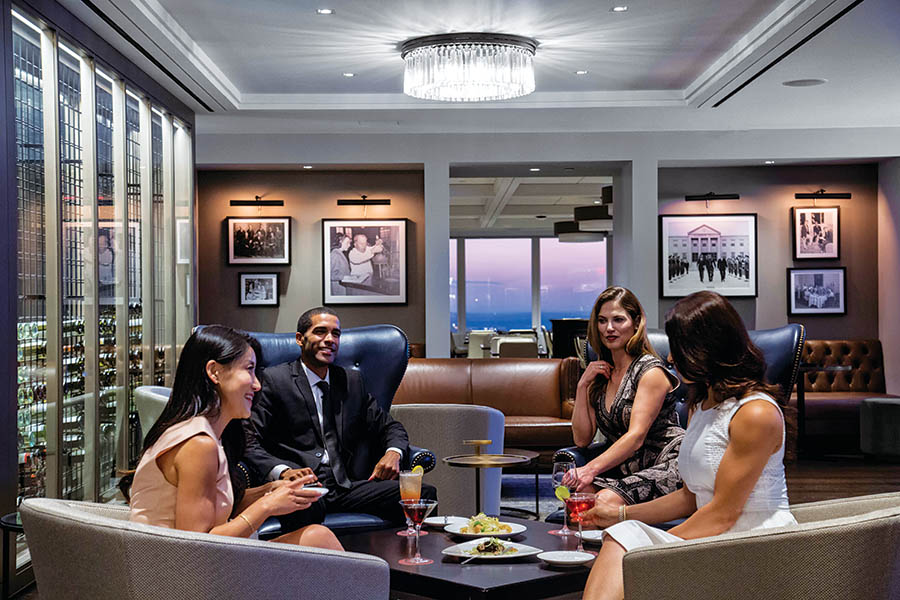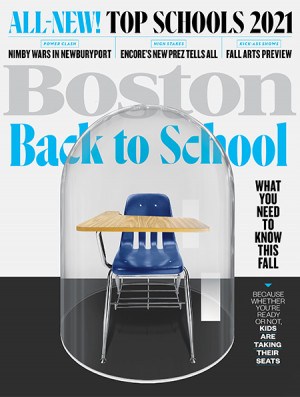Is UMass’s Marty Meehan Boston’s New King of Clubs?
Think Boston’s stodgy old world of private clubs won’t ever change? Clearly, you haven’t been to Marty Meehan’s UMass Club.

Portrait by Pat Piasecki
It’s Thursday night at the University of Massachusetts Club, and I’m drinking a glass of Cloudy Bay sauvignon blanc by the elevator when I spot U.S. Representative Richard Neal and an aide heading toward a party for Representative Stephanie Murphy of Florida, who serves on the Ways and Means Committee that Neal chairs. UMass President Marty Meehan is already working the room, chatting with Chet Atkins, former politician and fixer extraordinaire. Just down the hall, a company party has spilled out of the club’s second-largest event space, and next to that, a fundraiser for the Girl Scouts—complete with house-made, and surprisingly tasty, cookie-inspired cocktails—is still setting up. The main lounge area is rapidly filling with members who are eager to attend the meet-and-greet. Lieutenant Governor Karyn Polito, I’m told as I show myself around, has just slipped out.
Perched on the 32nd floor of One Beacon Street, the club hovers over the city. An elegant granite bar top is encircled by a lounge full of midcentury furniture and leather wingback chairs. To the left of the bar, there’s a dining room, small enough to feel collegial, yet still big enough that it’s hard to eavesdrop. Off the dining room, you’ll find event spaces, each with a panoramic view of the city. The clean-lined design is distinctly modern, with a neutral color scheme but enough creature comforts to feel warm and inviting.
Truth be told, the age-old elitism that goes hand in hand with private clubbiness isn’t exactly in vogue these days. The social and university clubs that once served as the epicenter of Boston society are still present, but the days of three-hour lunches over drinks and evenings spent smoking stogies by the fireplace are all but long gone. Even the Harvard Club of Boston—the gold standard for university clubs in this town—is being forced to adjust to changing times. Facing rising rents and declining traffic at its downtown location, it’s planning to move, quite possibly to a smaller space where members can more easily grab an informal lunch on the go.
And yet despite the odds, the UMass Club has risen from out of nowhere to create a new type of club—elite without elitism, a kind of top-of-the-line populist watering hole. It embraces the progressive values of New Boston, such as inclusivity; anyone can join, and it’s even relatively affordable, with an initiation fee that tops out at $600. It’s not particularly snobby or pretentious, yet is a place where the political elite feel right at home. In the past few years alone, it’s become a favorite lunch spot for Governor Charlie Baker and Polito. Joe Biden held a recent presidential fundraiser there. Several weeks before that, John Kerry made news at a book event at the club when he claimed President Trump was at the head of a “continuing conspiracy.”
“It is a very bipartisan place, to the extent that any place in Massachusetts is bipartisan,” says Atkins, a former congressman and onetime head of the Massachusetts Democratic Party. It’s also become a place favored by movers and shakers of all stripes: On a recent night, says Meehan (the first UMass president who actually attended the school as an undergrad), he was leaving an event at the club “and who did I bump into, but Bob Reynolds, CEO of Putnam, and co-owner of the Celtics Steve Pagliuca.”
In other words, as we enter a new decade, the UMass Club is winning one of the oldest games in town by creating something different—a comfortable so-called third place that’s welcoming to all. And in the process, it’s emerged as the hottest club in town. “You go to lunch at the Harvard Club, and they’re practically rolling out the oxygen tanks,” says PR maven Colette Phillips. “Now, everyone lunches at the UMass Club. It’s very New Boston.”

Presidential candidate Joe Biden at a fundraiser for his campaign, hosted at the club in November 2019. / Photo by Marc Bertrand
Tribalism runs deep in Boston. From the shabbiest dives of Allston to the toniest Back Bay parties, we’re a town of regulars. In turn, private social clubs have always been the ultimate expression of that reality, formed, as Nathan Shiverick wrote in Social History of the Greater Boston Clubs, as part of a “shrewd and successful rearguard action to substitute financial for [municipal] political power,” which the Irish were wresting away from the Brahmin elite. Once you graduated Harvard, you’d traditionally make your way to the Somerset Club (founded around 1826)—which was so uppish that one day when the place caught fire, members made the firemen use the servants’ entrance—or the more liberal Union Club (founded in 1863) or the artsier Tavern Club (founded in 1884) to find your place in the city. For men only, and quite formal, private clubs established the social pecking order. As noted in a 2000 Harvard Crimson article on the club scene, “‘At the Somerset,’ St. Botolph members have long chuckled, ‘they have the money; at the Union, they manage it; at the Algonquin, they’re trying to make it; and at the St. Botolph, they enjoy it.’”
University clubs arrived later. There was the College Club of Boston (1890), the first club for college-educated women in the country, and the University Club of Boston (1891), for anyone of good standing who had attended an Ivy League college and could score recommendations. The Harvard Club of Boston arrived in 1908. The mission of these establishments was similar to that of the social clubs: to cultivate a worthy social network. The difference, however, was that university clubs were less discerning—after all, the sorting had been done for them. Moreover, the university clubs often featured athletic facilities and were at the vanguard of Boston’s mighty squash scene. Together, the two types of institutions existed in lockstep and served as the infrastructure for elite social life in the city.
The first signs of a crack in the club structure appeared during the time between the two world wars, when clubs including the Somerset began to soften membership requirements in the face of mounting expenses. When, in the late 1980s, the clubs were forced to accept women or lose their liquor licenses, it proved a blessing, albeit an unwelcome one. “They were going into the dust,” says one member who asked not to be identified. “And women turned them around.”
Another seismic change in the old order happened in 1998, when the Boston College Club opened. Its founding was meant to signal BC’s ascendance from a lowly commuter college for Catholics to a pillar of power in the Hub. It was viewed as less stuffy than the Harvard Club, and emerged as a notable hot spot. The Boston Business Journal even commented on a Harvard Club member sneaking over to the BC Club for a meal—a sign, the reader was meant to assume, that BC might be standing toe to toe in other ways, too.
At the same time, as the 21st century began, social clubs were arguably losing their grip on power in the city. While they might once have determined a Harvard man’s fate, mused the same Harvard Crimson article, “one no longer need frolic through WASP theme parks to claw one’s way to the top. Other avenues to power and high society avail themselves.” This was the climate when UMass decided to open a university club. Like the BC Club before it, UMass wanted to show that it was a real player in the city and not merely a so-called safety school. “We really wanted to raise the brand identity,” says Jack Wilson, the former president of UMass. “I was a bit shocked when I came to Massachusetts and discovered that its reputation was much better outside the state than it was inside the state.” Powerful alums, namely GE’s Jack Welch, were also frustrated that there wasn’t a place for UMass grads to get together and network, says Emmet Hayes, a UMass alum and former state representative who is now on the board of the UMass Club. The decision to launch a club, Wilson says, “was part of that branding initiative to say, ‘Hey, we’re here. We matter. We’ve done a lot of great things that you’re not hearing enough about.’”
The idea to open the club coincided with an opportunity: The university was abandoning its president’s office at One Beacon Street for one at State Street’s former digs in the Financial District, which, it so happened, came with a defunct club that the landlords were willing to cut the school a deal on. So in 2005, the original UMass Club opened its doors in an 18,000-square-foot space at the top of 225 Franklin Street in Post Office Square. Run by the same company that managed the BC Club, it was the platonic image of a stuffy university club, an imitation relic: think wood-paneled rooms and walls covered with UMass memorabilia. Looking at it, you could almost smell the cigar smoke.
Still, there were distinctions that set the UMass Club apart, even at the start. First, it wasn’t just for UMass alums—because the idea was to boost the school’s cachet, its board decided anyone who wanted to hop on the UMass brand should be able to join. It was also designed to be affordable. After all, says Wilson, UMass is “a university for the people. That’s the brand.” Today, there’s a sliding scale that tops out at $120 a month for membership, plus the $600 maximum initiation fee, so you don’t have to have limitless money to burn in order to join. And unlike at other clubs, anyone can lay down a credit card and pick up (or split) the tab, so the club member doesn’t always get stuck with the bill.
It seemed like a smart business model. Then the worst happened: Not many people came. Even the people who were supposed to like it didn’t—one board member remembers a university official swearing that his dinner there was one of the worst meals he’d ever had. Membership numbers were underwhelming, rising to about 800 over the course of a decade, leading to questions of why a public university was burning money on a club that almost no one used at a time when it was raising tuitions. What was meant to be a crown jewel was rapidly shaping up to be a black eye.

Photo by Gensler
When Marty Meehan took office as president of UMass in July 2015, the club was a sinkhole for cash and a ripe target for critics of public spending. In the decade since it was founded at 225 Franklin Street, the club had sucked up more than $4 million in subsidies from the university. Critics cast it as a money-losing venture. Meehan didn’t think much of the place either. “If I had an important lunch,” he says, “I was not likely to go up to the dining room to have that lunch—there weren’t enough people there. It wasn’t a happening place.”
Meehan may not have liked the club, but he believed in its ability to promote the university and stoke fundraising. With the 10-year lease running out on the Franklin Street location, Meehan knew it was time to try something different. The UMass Club 2.0 didn’t just ditch its old space—it ditched its whole vibe. The wood paneling, the knockoff Harvard Club décor—all that jazz went out the window, replaced by an airy, modern space. It also ditched its management company, ClubCorp, and brought in UMass Dining, whose food at UMass Amherst had just been named among the best in the nation by the Princeton Review.
For his part, Meehan obsessed over the details. After talking with Legal Sea Foods owner Roger Berkowitz, he insisted that the club start serving Cloudy Bay sauvignon blanc, which was Legal’s bestselling wine during the summer. (At first, Meehan says, employees thought it was just because he liked it.) When Meehan saw restaurant staffers hassling communications guru George Regan (who represents this magazine) for trying to order a cheeseburger off the bar menu while seated in the dining room, he struck down the arbitrary divide between the two menus. Most important, Meehan practically haunted the place—any lunch date or breakfast meeting he had, he had it at the club. “I think [the turnaround] happened fairly quickly—maybe in a year or two,” says Phil Johnston, a former chair of the Massachusetts Democratic Party. “From the day he became president, Marty made the club a priority.”
He wasn’t the only one. Then–state Senate President Stan Rosenberg, who had eaten at the club’s old location just a handful of times, was second only to Meehan in how often he was at the new place. “He came up here a lot,” Meehan says. “He brought other members up, and he had his fundraisers here.” By Rosenberg’s own accounting, he sometimes ate three meals a day at the club, with meetings there in between. After, Baker became a fixture, followed by House Speaker Robert DeLeo. “If the governor has a political meeting, he does it here,” says Meehan, “and nobody bothers him.” Baker usually sits at the table in the back left of the dining room, next to the windows, where he can scan the room.
Despite the revolving door of power players, the one thing Meehan didn’t change was the club’s inclusive policies, in part because they still represented the UMass ethos. “[The UMass Club is] something special, but it’s not arrogant,” says Dave Barbato, CEO of Talent Retriever, a recruiting firm. “Whenever I bring a client, they say, ‘I see why you want to be a member.’ It doesn’t have the big mahogany walls; it doesn’t cost hundreds of thousands of dollars to join. It’s like UMass.”
In a town that’s full of history but breaking new ground every day, this sensibility has turned into a major advantage for the club. When, for instance, the Links, a prominent black women’s volunteer service organization that counts Congresswoman Ayanna Pressley among its members, was looking for a location to host its elaborate Carnival-themed biannual fundraising party in 2017, it picked the UMass Club in part because it didn’t have a recent history of exclusion that would have made its members feel unwelcome. “For us, it provided a balance between something that felt really special, but also felt accessible,” says Stephanie Anderson Garrett, who, as the Boston group’s corresponding secretary, helped select the location. “We wanted to feel like our guests were being transported. But we’re also sensitive to some of this history, as black women in Boston, that some places have not been welcoming.” They chose it again in 2019, giving the UMass Club the distinct honor of being the only place the Links has ever thrown its parties twice.
Others are doing the same. Herby Duverné, who runs a small business, says he ditched the Algonquin for the UMass Club, passing on the Harvard Club in the process. “The people at the Algonquin Club were part of the old money, the old guard. Here you have up-and-coming people,” he says. “It’s what the New Boston represents. You find all different kinds of people, very diverse—a lot of people who were black business members like me.”
Another way UMass is forging a new path is with its embrace of doing business in a manner most social clubs have historically shunned. There’s no “no cell-phone” policy here because, heck, business is practically the point. “It’s the only place in town that I’m aware of today where you can see a whole lot of friends who are engaged in similar occupations—politics, business,” Johnston says. “Years ago, the Parker House served that purpose.” And this vibe, apparently, has helped the club more than double its membership over the past four years, to more than 1,700 today. It turns out, though, that they’re not the only ones reinventing themselves for a new generation.

The bar at the UMass Club offers weeknight specials aimed at luring younger members. / Photo by Gensler
In many ways, Meehan’s UMass Club was ahead of its time. Recent years have ushered in the rise of a new brand of club, one that focuses on networking and culture as much as on wealth and status. Take the Wing, the stylish women’s coworking space that opened in Boston, or the Quin, a rebrand of the Algonquin Club that developer/philanthropist Sandra Edgerley says will be a chic cultural hub when it ultimately opens. Culturally, spaces such as the hyper-luxe gym Equinox and the now-scandal-plagued coworking company WeWork function like clubs as well. “I think there’s been a bit of a renaissance in clubs,” says Karen Galvin, the chief marketing officer of the Harvard Club. “There’s a trend of younger people considering clubs in a way that they might not have done maybe 15 years ago.” It makes sense: In our social-media-saturated age, millennials are looking for places where they can meet other people in person—make real connections, find new friends—who aren’t in their immediate peer group.
All of that, of course, raises the question of how a storied place like the Harvard Club will bring this new generation into the fold. It’s practically synonymous with Old Boston and the early generation of clubs, where the buy-in is expensive and the atmosphere is formal.
When I visit the Harvard Club one afternoon to learn the answer, I’m immediately struck by the silver chandeliers and paintings of mallards, which make me feel as though I’ve stepped back in time. But then I meet Michael Gaines (Harvard MBA), Reverend Amy Norton (Harvard master of divinity), and Courtney Sharpe (Harvard master of urban planning). Gaines, for his part, hadn’t planned to join but was lured in when he struck up a conversation with an older man who happened to be an alum and who talked him into reconsidering. Norton and Sharpe were both looking for what urban planners call a third place—somewhere that’s neither home nor work—where they could spend time. All of them were delighted to find the club was aggressively looking for ways to be more welcoming and diverse.
It’s not just inclusiveness that will keep the Harvard Club relevant in the future; it’s also the club’s ability to make smart business decisions. The eventual shuttering of the Financial District’s Harvard Club at One Federal Street was prompted by a 105 percent hike in rent and the fact that it didn’t meet the needs of members anymore, says Steven Cummings, the GM of the Harvard Club. Only about a quarter of the 19,500-square-foot space—the main bar and dining areas—is in regular use, an internal study found, while conference rooms remain largely vacant. As a result, the club is on the hunt for a smaller space where members can grab lunch on the go.
Cummings, for his part, insists that the upcoming move isn’t a sign of trouble—it’s a sign that the Harvard Club is being responsive to members’ needs (other offerings include family movie nights and “clubs within a club” that connect members with like interests, such as skiing). If other clubs are struggling, he says, it’s because they’re no longer giving people what they really want.
This is a puzzle that in some ways the UMass Club has already solved by trying to be the best place in town to meet a client, grab lunch, and maybe enjoy a cocktail with a world-class view. Its premise (at least, its implied premise) is that it’s possible to build an elite club based on who opts in, not who’s kept out.
Sitting in the dining room on a Tuesday morning, at Charlie Baker’s regular table no less, Meehan looks down on the State House and reflects on why the club has been such a success. “Six months after getting here, it became clear that this had the potential to have real buzz,” he says. It wasn’t just that the politicos had started coming, either. It was the fact that, after selling this place to anyone who would listen—pitching it as a spot where everyone was welcome—the UMass Club suddenly took on a life of its own. “Now,” he says, shrugging his shoulders as if to acknowledge a combination of luck and great timing, “it sells itself.”

